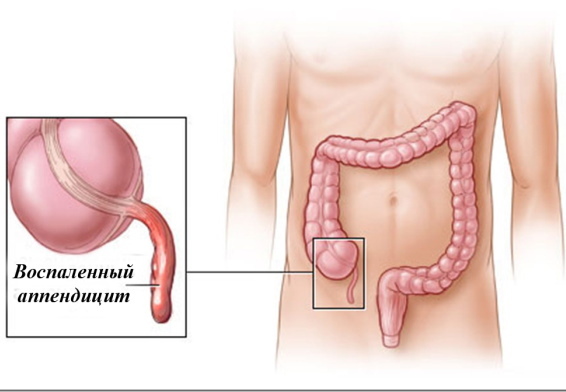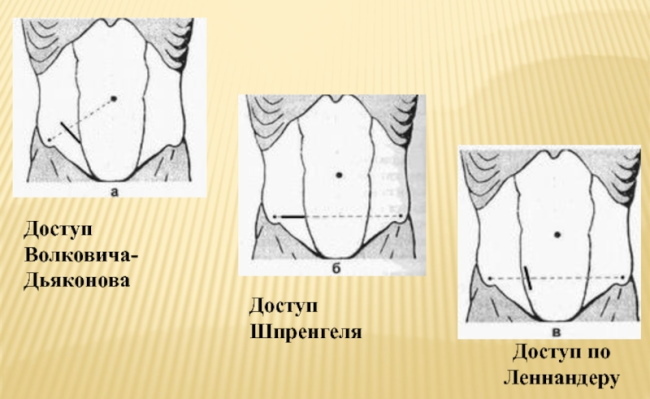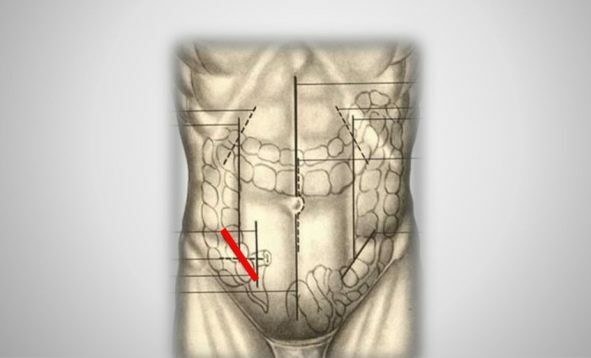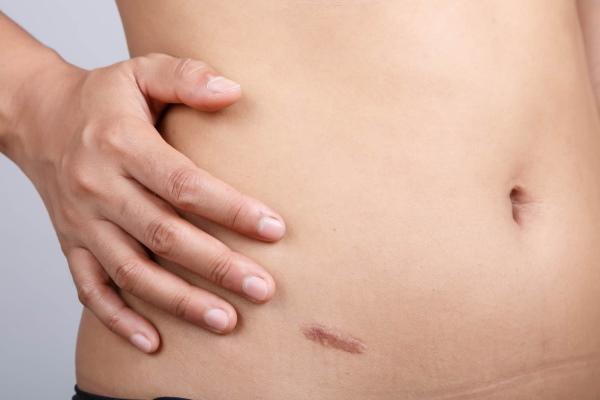Acute appendicitis or inflammation of the appendix the cecum is one of the most common diseases requiring surgical intervention in the structure of abdominal pathologies. Every year, with such a diagnosis, 300-500 people are admitted to hospitals for every 100 thousand of the population.
An appendectomy can be done in a variety of ways. Removal of the appendix according to Volkovich-Dyakonov refers to the traditional (classical) types of abdominal operations. As with all types of surgical intervention, such an operation can be accompanied by complications.
Record content:
- 1 What is appendectomy?
- 2 Indications for surgery
- 3 Contraindications to surgery
- 4 Why is the operation dangerous?
- 5 Patient preparation
- 6 What kind of anesthesia is used?
- 7 Types of appendectomy
-
8 The process of performing appendectomy with the Volkovich-Dyakonov incision
- 8.1 Operation Algorithm
- 8.2 Duration of intervention
- 8.3 The period of rehabilitation and recovery
-
9 With a pararectal Lenander incision
- 9.1 Operation Algorithm
- 9.2 Duration of intervention
- 9.3 The period of rehabilitation and recovery
- 10 Possible complications of operations
- 11 Video: laparoscopic appendectomy
What is appendectomy?
Appkedectomy is a medical term formed from 2 words: "appendix" and the Greek "εκτομή" ("excision"). It means the removal of the appendix - the appendage of the colon.
This operation is performed in most cases with acute appendicitis - inflammation in the appendix. This disease can occur both in the first year of life in children and in old age. In women, it manifests itself 2 times more often than in men.
There are several theories explaining the development of the inflammatory process: from the activation of the intestinal microflora (any microorganisms inhabiting the gastrointestinal tract) against the background of blockage of the lumen of the appendix with feces before the presence in the body helminths. Most often, appendicitis is acute, the tissues quickly necrotize (die off).
Symptoms of this condition are right lower abdominal pain, vomiting, fever, diarrhea - allow us to suspect this particular disease in the first place. It requires urgent hospitalization, as necrosis of the appendix leads to severe complications listed below.
Appendectomy according to Volkovich-Dyakonov is one of the ways to remove the appendix. In acute appendicitis, the operation should be performed within 2 hours after admission to the hospital.
Pregnancy in this case is not a contraindication. Only if doctors doubt the diagnosis, the patient is monitored for 6 hours and additional examinations to clarify the picture of the disease.
Indications for surgery
The indications for surgical intervention are the following conditions:
- Acute appendicitis, in which there are pronounced clinical signs described above.
- Chronic appendicitis. Most often it occurs as a consequence of acute appendicitis. This form of the disease is much less common than the first. Gradually, atrophy of the mucous membrane occurs in this area of the intestine, connective tissue grows. This condition is no less dangerous than the previous one and threatens with the same complications.

- Tumors of the appendix. Their prevalence is 40 cases per 5000 appendectomies. About 10% of them are adenocarcinomas (cancerous tumors).
Cancellation of surgery is life-threatening, since appendicitis in most cases is the cause of the development of peritonitis.
Contraindications to surgery
Appendectomy according to Volkovich-Dyakonov has the only absolute contraindication - it is agonal, or a near-death condition in which the vital functions of the body are significantly inhibited person.
The operation can also be postponed in 2 cases:
- Appendicular colic - convulsive contraction of the muscular membrane of the appendix or a rapidly passing attack of acute appendicitis. If the patient has a normal body temperature and the level of leukocytes in the blood is not increased, then additional tests are prescribed for him within 4-6 hours. It is possible to find out whether colic is associated with functional changes or an inflammatory process develops in the process, it is possible only during excision.
- Well-formed appendicular infiltrate - a conglomerate of tissues tightly welded together, not accompanied by the formation of an abscess (purulent inflammation).
In all doubtful cases, surgery is indicated for patients, since complications from appendicitis are much more serious and develop almost always, in contrast to the side effects after surgery interference.
Why is the operation dangerous?
The incidence of postoperative complications is 5-9%. However, if we compare it with the mortality from appendicitis itself (in the 19th century, for example, it accounted for 40% of patients), then this is an insignificant figure. The cause of death in untreated appendicitis in most cases is diffuse peritonitis (inflammation of the peritoneum) and acute intestinal obstruction.
Most complications arise in those patients who have sought medical help late or with an untimely diagnosis. Most often, they consist in the formation of abscesses in various areas of the abdominal cavity, which is associated with insufficient complete removal of the affected tissues during the operation. Other types of complications are listed below.
Patient preparation
The preoperative preparation of the patient is as follows:
- installation of a gastric tube for gastric lavage;
- taking a hygienic shower;
- shaving the operating area on the abdomen;
- infusion therapy to eliminate electrolyte disorders (with the introduction of antibacterial drugs to prevent peritonitis).
What kind of anesthesia is used?
For anesthesia during the operation, the following methods are used:
- intravenous ("general") anesthesia;
- combined anesthesia (intravenous and inhalation);
- spinal anesthesia (injecting anesthetic into the spine, "turning off" the sensitivity of the lower body while maintaining consciousness);
- in more rare cases, local anesthesia according to A.V. Vishnevsky (introduction of 0.25% novocaine solution into the operating area).
Types of appendectomy
Several methods of appendectomy are used in surgery.
The most common of them, as well as their advantages and disadvantages, are shown in the table below:
| Method | The essence of the method | Dignity | Flaws |
| Laparoscopy | Trocars are inserted into the abdominal cavity - hollow tubes, inside which there is a surgical instrument. |
|
|
| Access by Volkovich - Dyakonov | The tissue incision is made obliquely, parallel to the inguinal ligament. |
|
|
| Lenander pararectal laparotomy | The incision is made in the longitudinal direction, at a distance of 1 cm from the right rectus muscle. |
|
|
| Winckelmann's transverse laparotomy | The incision is made in the transverse direction at the level of the bispinal line tangent to the wings of the ilium. |
|
|
Laparoscopy is currently the most promising surgical method not only for appendicitis, but also for other diseases.
The process of performing appendectomy with the Volkovich-Dyakonov incision
Appendectomy, which is performed according to Volkovich-Dyakonov, is one of the most common techniques.

Open abdominal operations are performed instead of laparoscopy in the following cases:
- pathological changes in the appendix of a pronounced form;
- blood clotting disorders;
- involvement of the cecum in the inflammatory process;
- severe pathologies of internal organs - liver, kidneys, heart;
- late pregnancy;
- the presence of dense infiltrates in the process area;
- the formation of adhesions that make it difficult to isolate the appendix.
Operation Algorithm
Appendectomy according to Volkovich-Dyakonov is performed as follows:
- The skin is excised in a straight, perpendicular line connecting the navel and the upper portion of the right iliac bone. The length of the incision depends on the thickness of the subcutaneous tissue - the thicker it is, the larger the incision needs to be made.

- The subcutaneous tissue is dissected with a scalpel or moved apart with a special tool.
- The underlying tissue is incised up to the aponeurosis - a tendon plate made of collagen and elastic fibers.
- The fibers of the external oblique muscle of the abdomen are dissected using curved surgical scissors (Cooper scissors).
- Hemostatic clamps push the muscle layer apart.
- The preperitoneal tissue is also bluntly pulled apart.
- The peritoneum is grasped with two clamps and dissected.
- The edges of the peritoneum are fixed with clamps with gauze napkins.
- If the dome of the cecum is poorly identified, then the incision is widened.
- Check the absence of adhesions with the index finger.
- The cecum is pulled out by the front wall and taken out into the wound. The appendix comes out with it.
- The appendix is grasped with tweezers and removed from the abdominal cavity. If there are adhesions, they are stratified or dissected.
- The appendix is fixed with a soft clamp.
- After this, the appendectomy itself is performed. The surgeon can act in 2 ways: first, remove the process and treat the remaining area (antegrade method), or first bandage it, treat it with iodine and then remove it. The latter option is used in cases where there is an adhesive process in the abdominal cavity or with an atypical location of the appendix, since it is difficult to remove it into the wound.
Duration of intervention
The average duration of the operation is 30-45 minutes. During surgery, the condition of the peritoneum, the presence of pus, and a sample for bacterial culture are assessed.
In the presence of complications and the need for additional manipulations, the duration of the operation can be 3 hours.
The period of rehabilitation and recovery
During the recovery period, the following recommendations must be observed:
- With a favorable course of the postoperative period, you can eat food after 18-24 hours, turn in bed - after 2-3 hours, get out of bed - after 12 hours.
- In order to prevent complications, you need to take antibacterial drugs that the doctor will prescribe. Analgesics are also used to reduce pain.
- For the first 1-2 weeks, you should avoid active movements and rest more. Food should be easily digestible, mainly boiled and steamed, you need to refrain from spicy, smoked, salty foods, coarse fiber, which causes increased flatulence. It is also necessary to monitor the condition of the seam so that it does not fester and does not diverge. The seam cannot be wetted for the first 7 days. After that, you can take a shower, but you can not rub the area with a seam.
- For a month after the operation, do not lift weights and avoid strokes in the abdomen.
Discharge from the hospital in the absence of complications is made on days 3-9.
With a pararectal Lenander incision
Removal of the appendix with the Lenander approach is less widespread than the Volkovich-Dyakonov approach. Its significant disadvantage is that the widening of the incision leads to the intersection of the nerves passing into the rectus abdominis muscle. This can lead to her paralysis.
Its significant disadvantage is that the widening of the incision leads to the intersection of the nerves passing into the rectus abdominis muscle. This can lead to her paralysis.
Operation Algorithm
Lenander appendectomy is performed in the following sequence:
- The vagina (the receptacle of the sac-shaped muscles) of the rectus muscle is opened in the longitudinal direction. The length of the incision is approximately the same as in the previous case - 8-10 cm.
- The skin, subcutaneous tissue, the posterior wall of the vagina and the peritoneum are excised in layers. In this case, the muscle itself is pushed back in the medial direction.
- The process is removed in one of the 2 ways described above.
- Wound suturing is also carried out in layers, using absorbable synthetic sutures.
Duration of intervention
The duration of the operation in this case is on average 40-60 minutes.
The period of rehabilitation and recovery
The features of the recovery period are in many ways similar to the removal of the appendix with access according to Volkovich-Dyakonov. For the prevention of adhesions, an early start of moderate physical activity is recommended (in particular, walking will be useful), without stress on the press. Discharge is possible for 5-7 days.
Severe pain after surgery may last for 2-3 days, then gradually subside. It also requires compliance with a gentle diet, which should be aimed at eliminating constipation, as they contribute to the tension of the abdominal muscles.
If the suture was made of threads that do not dissolve, then they are removed for 7-10 days. For faster healing of the outer surface of the suture, you can use Bepanten ointment.
Physical activity on the press with a favorable course of the postoperative period is allowed after 4-5 months. Also, do not worry about the large seam size. If the incision is insufficient, the likelihood of complications increases as access is more difficult. This measure is also necessary for patients with thick subcutaneous tissue.
Possible complications of operations
Appendectomy according to Volkovich-Dyakonov can lead to the following complications:
- abscesses with insufficient complete removal of the effusion (symptoms are fever, dull pain in the abdomen, false urge to defecate);
- peritonitis (with destructive forms of the disease);
- rupture of the appendix with late surgery;
- bleeding if blood vessels are damaged;
- thrombophlebitis of the pelvic veins;
- wound infection;
- sepsis;
- acute intestinal obstruction;
- the formation of intestinal fistulas;
- hematoma.
In more rare cases, complications from the respiratory, cardiovascular and genitourinary systems may occur. The development of a purulent process causes severe intoxication, irreversible changes in vital organs, deterioration of metabolic reactions. If the abscess breaks into the abdominal cavity, then in most cases this entails the death of the patient.
More than 500 thousand appendectomies are performed in Russia every year. The mortality rate is about 1%. In recent years, there has been a tendency for the erased course of the disease, which complicates timely diagnosis and surgical intervention.
Operation with access according to Volkovich-Dyakonov is currently inferior in some parameters to laparoscopy, but it is still widely used in surgical practice.
Video: laparoscopic appendectomy
About Laparoscopic Appendectomy:



